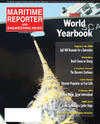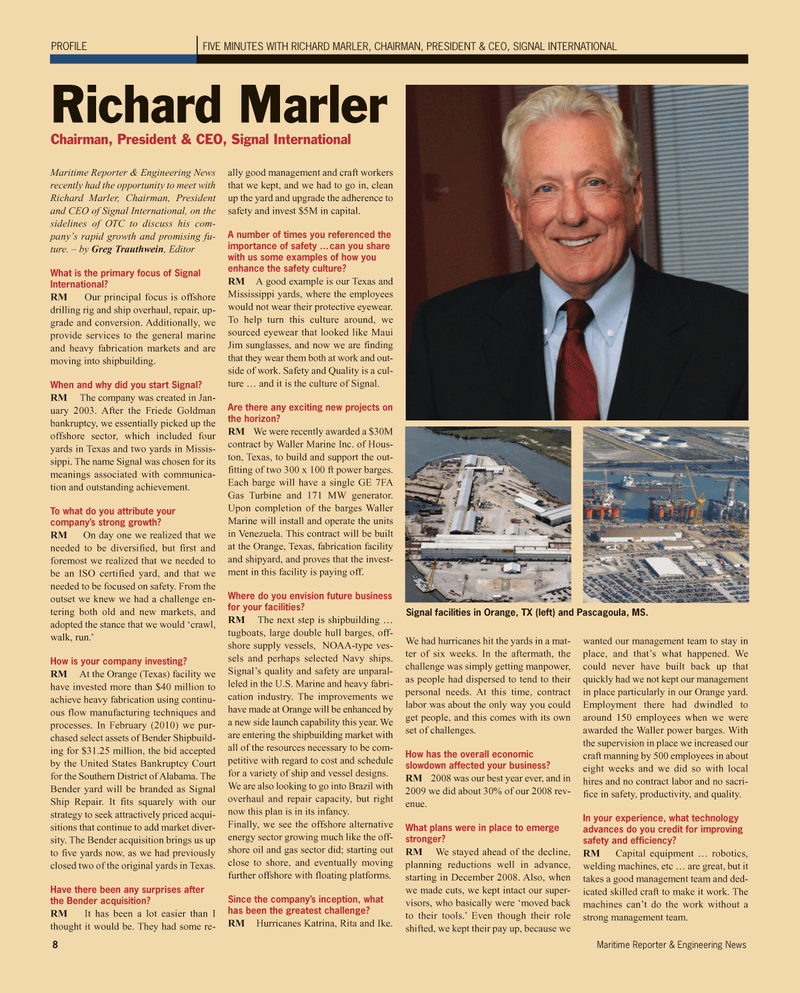
Page 8: of Maritime Reporter Magazine (June 2, 2010)
Read this page in Pdf, Flash or Html5 edition of June 2, 2010 Maritime Reporter Magazine
8 Maritime Reporter & Engineering News
PROFILE FIVE MINUTES WITH RICHARD MARLER, CHAIRMAN, PRESIDENT & CEO, SIGNAL INTERNATIONAL
Maritime Reporter & Engineering News recently had the opportunity to meet with
Richard Marler, Chairman, President and CEO of Signal International, on the sidelines of OTC to discuss his com- pany’s rapid growth and promising fu- ture. – by Greg Trauthwein, Editor
What is the primary focus of Signal
International?
RM Our principal focus is offshore drilling rig and ship overhaul, repair, up- grade and conversion. Additionally, we provide services to the general marine and heavy fabrication markets and are moving into shipbuilding.
When and why did you start Signal?
RM The company was created in Jan- uary 2003. After the Friede Goldman bankruptcy, we essentially picked up the offshore sector, which included four yards in Texas and two yards in Missis- sippi. The name Signal was chosen for its meanings associated with communica- tion and outstanding achievement.
To what do you attribute your company’s strong growth?
RM On day one we realized that we needed to be diversified, but first and foremost we realized that we needed to be an ISO certified yard, and that we needed to be focused on safety. From the outset we knew we had a challenge en- tering both old and new markets, and adopted the stance that we would ‘crawl, walk, run.’
How is your company investing?
RM At the Orange (Texas) facility we have invested more than $40 million to achieve heavy fabrication using continu- ous flow manufacturing techniques and processes. In February (2010) we pur- chased select assets of Bender Shipbuild- ing for $31.25 million, the bid accepted by the United States Bankruptcy Court for the Southern District of Alabama. The
Bender yard will be branded as Signal
Ship Repair. It fits squarely with our strategy to seek attractively priced acqui- sitions that continue to add market diver- sity. The Bender acquisition brings us up to five yards now, as we had previously closed two of the original yards in Texas.
Have there been any surprises after the Bender acquisition?
RM It has been a lot easier than I thought it would be. They had some re- ally good management and craft workers that we kept, and we had to go in, clean up the yard and upgrade the adherence to safety and invest $5M in capital.
A number of times you referenced the importance of safety … can you share with us some examples of how you enhance the safety culture?
RM A good example is our Texas and
Mississippi yards, where the employees would not wear their protective eyewear.
To help turn this culture around, we sourced eyewear that looked like Maui
Jim sunglasses, and now we are finding that they wear them both at work and out- side of work. Safety and Quality is a cul- ture … and it is the culture of Signal.
Are there any exciting new projects on the horizon?
RM We were recently awarded a $30M contract by Waller Marine Inc. of Hous- ton, Texas, to build and support the out- fitting of two 300 x 100 ft power barges.
Each barge will have a single GE 7FA
Gas Turbine and 171 MW generator.
Upon completion of the barges Waller
Marine will install and operate the units in Venezuela. This contract will be built at the Orange, Texas, fabrication facility and shipyard, and proves that the invest- ment in this facility is paying off.
Where do you envision future business for your facilities?
RM The next step is shipbuilding … tugboats, large double hull barges, off- shore supply vessels, NOAA-type ves- sels and perhaps selected Navy ships.
Signal’s quality and safety are unparal- leled in the U.S. Marine and heavy fabri- cation industry. The improvements we have made at Orange will be enhanced by a new side launch capability this year. We are entering the shipbuilding market with all of the resources necessary to be com- petitive with regard to cost and schedule for a variety of ship and vessel designs.
We are also looking to go into Brazil with overhaul and repair capacity, but right now this plan is in its infancy.
Finally, we see the offshore alternative energy sector growing much like the off- shore oil and gas sector did; starting out close to shore, and eventually moving further offshore with floating platforms.
Since the company’s inception, what has been the greatest challenge?
RM Hurricanes Katrina, Rita and Ike.
We had hurricanes hit the yards in a mat- ter of six weeks. In the aftermath, the challenge was simply getting manpower, as people had dispersed to tend to their personal needs. At this time, contract labor was about the only way you could get people, and this comes with its own set of challenges.
How has the overall economic slowdown affected your business?
RM 2008 was our best year ever, and in 2009 we did about 30% of our 2008 rev- enue.
What plans were in place to emerge stronger?
RM We stayed ahead of the decline, planning reductions well in advance, starting in December 2008. Also, when we made cuts, we kept intact our super- visors, who basically were ‘moved back to their tools.’ Even though their role shifted, we kept their pay up, because we wanted our management team to stay in place, and that’s what happened. We could never have built back up that quickly had we not kept our management in place particularly in our Orange yard.
Employment there had dwindled to around 150 employees when we were awarded the Waller power barges. With the supervision in place we increased our craft manning by 500 employees in about eight weeks and we did so with local hires and no contract labor and no sacri- fice in safety, productivity, and quality.
In your experience, what technology advances do you credit for improving safety and efficiency?
RM Capital equipment … robotics, welding machines, etc … are great, but it takes a good management team and ded- icated skilled craft to make it work. The machines can’t do the work without a strong management team.
Richard Marler
Chairman, President & CEO, Signal International
Signal facilities in Orange, TX (left) and Pascagoula, MS.

 7
7

 9
9
